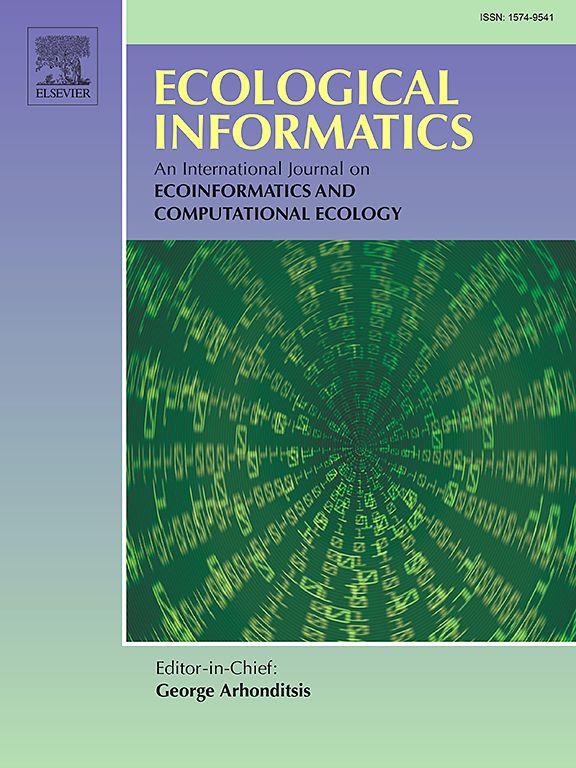Assessing Gonipterus defoliation levels using multispectral unmanned aerial vehicle (UAV) data in Eucalyptus plantations
IF 5.8
2区 环境科学与生态学
Q1 ECOLOGY
引用次数: 0
Abstract
Invasive insect pest Gonipterus sp. n. 2 (Coleoptera: Curculionidae) threatens Eucalyptus species, causing defoliation and yield loss through adult and larval feeding. Early detection is important for early intervention to prevent pest outbreaks. As conventional insect pest monitoring methods are time-consuming and spatially restrictive, this study assessed the potential of UAV monitoring. Multispectral imagery was obtained with Unmanned Aerial Vehicles (UAVs) across six different stands of young Eucalyptus dunnii with varying levels of Gonipterus sp. n. 2 infestations. Some stands were revisited, a total of 9 datasets were covered. Reference damage levels were obtained through visual assessments of (n = 89–100) trees at each site. Across sites, a decrease in canopy reflectance in both the visual and the near-infrared domains with increasing damage levels was consistently observed. Several vegetation indices showed consistent patterns, but none showed site independence. XGBoost, Support Vector Machine and Random Forest (RF) were used to predict damage levels using five input spectral data types. XGBoost performed best, closely followed by RF. Both models consistently selected very similar features. The best-performing models included reflectance, vegetation indices and grey-level co-occurrence matrix data. When data from 10 different wavelengths were used, the highest classification accuracy was 92 % across all sites in classifying defoliation levels. With a classical 5-band multispectral camera, accuracy was 88 %, but distinguishing medium damage from low remained challenging. However, the method was less reliable when trained and validated on separate fields. This study highlights the potential of multi-site datasets in increasing the model's generalization, using UAV based multispectral imagery to assess Gonipterus sp. n. 2 damage and demonstrating reliable upscaling from individual tree assessments to stand scale. However, it also recognises the difficulty of generating a robust model that performs well on untrained sites.
利用多光谱无人机(UAV)数据评估桉树人工林Gonipterus落叶水平
入侵害虫Gonipterus sp. n. 2(鞘翅目:Curculionidae)威胁桉树物种,通过成虫和幼虫的摄食造成落叶和产量损失。早期发现对于早期干预以防止虫害暴发非常重要。针对传统害虫监测方法耗时长、空间限制大的特点,本研究评估了无人机监测的潜力。利用无人机(uav)在不同程度的Gonipterus sp. n. 2侵染的6个不同桉树幼林上获得了多光谱图像。重新访问了一些展台,总共覆盖了9个数据集。通过对每个地点(n = 89-100)棵树木的目视评估获得参考损害水平。在不同的地点,随着破坏程度的增加,冠层反射率在视觉和近红外区域均呈下降趋势。多个植被指数表现出一致的格局,但均不具有立地独立性。使用XGBoost、支持向量机和随机森林(RF)预测五种输入光谱数据类型的损害程度。XGBoost表现最好,RF紧随其后。两种模型都选择了非常相似的功能。表现最好的模型包括反射率、植被指数和灰度共生矩阵数据。当使用来自10个不同波长的数据时,在对落叶水平进行分类时,所有站点的最高分类准确率为92%。使用经典的5波段多光谱相机,准确率为88%,但区分中等伤害和低伤害仍然具有挑战性。然而,当在单独的领域进行训练和验证时,该方法的可靠性较低。本研究强调了多站点数据集在提高模型泛化方面的潜力,使用基于无人机的多光谱图像来评估Gonipterus sp. n. 2的损害,并展示了从单个树木评估到林分尺度的可靠升级。然而,它也认识到生成一个在未经训练的站点上表现良好的健壮模型的困难。
本文章由计算机程序翻译,如有差异,请以英文原文为准。
求助全文
约1分钟内获得全文
求助全文
来源期刊

Ecological Informatics
环境科学-生态学
CiteScore
8.30
自引率
11.80%
发文量
346
审稿时长
46 days
期刊介绍:
The journal Ecological Informatics is devoted to the publication of high quality, peer-reviewed articles on all aspects of computational ecology, data science and biogeography. The scope of the journal takes into account the data-intensive nature of ecology, the growing capacity of information technology to access, harness and leverage complex data as well as the critical need for informing sustainable management in view of global environmental and climate change.
The nature of the journal is interdisciplinary at the crossover between ecology and informatics. It focuses on novel concepts and techniques for image- and genome-based monitoring and interpretation, sensor- and multimedia-based data acquisition, internet-based data archiving and sharing, data assimilation, modelling and prediction of ecological data.
 求助内容:
求助内容: 应助结果提醒方式:
应助结果提醒方式:


